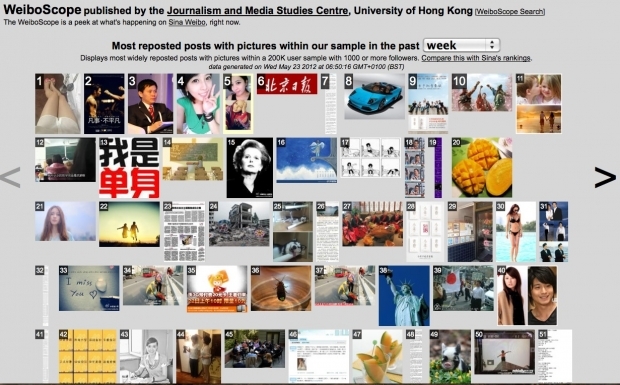With more than 300 million registered users, the popular microblogging service Sina Weibo—sometimes called the Chinese Twitter—can offer unique insights into the quotidian musings of Chinese netizens. One way to sort through the barrage of microblogs posted each second is to make use of aggregation tools that provide a list of the most reposted or most commented-on microblogs within a specified period of time.
Sina itself provides one such aggregation tool.
Often, the top trending posts are banal. But even run-of-the-mill entries (a post expressing enthusiasm for birthday celebrations or a saccharine Hallmark-esque rumination on true love—to cite two recently trending examples) can serve as touchstone for debates on weightier social issues. The process often begins with an image, joke, or even an ordinary news headline. Take, for example, the most popular trending topic as of May 23, 2012—the report of a malfunctioning HSBC ATM in England that for two hours mistakenly dispensed twice the amount customers wanted to withdraw. According to a report first published by Britain’s Daily Mail on May 19, though some customers walked away with hundreds of pounds, HSBC ultimately accepted responsibility for the mistake, saying it would not ask customers to return the money.
In just a few days, the story was reposted 62,730 times on Sina Weibo. Many of the more than 17,000 comments related the story to a similar situation that occurred closer to home in 2008, in which a young migrant worker named Xu Ting was initially sentenced to life imprisonment after withdrawing more than 170,000 RMB from a malfunctioning ATM in Guangdong province. Some commenters dismissed the news item as an overblown publicity ploy on the part of HSBC. Others expressed a desire for banks in China to act more sympathetically. A popularly reposted comment said: “In our mighty country, you must be very careful when going to the ATM. You’re scared that it’ll dispense too much money, or that it’ll dispense too little, or that it’ll feed you counterfeit money. Then you have to worry about petty thieves lurking around and you have to worry about being followed. Even if you don’t use your card to withdraw money, you still have to worry about fraud. You might as well accept the responsibility yourself.”
The extent to which Sina’s aggregation tool may be said to represent ‘reality,’ however, is limited by the real ‘reality,’ which is that Sina’s aggregate rankings do not include microblog posts that have been censored. WeiboScope, an image aggregation tool created by the Journalism and Media Studies Centre at the University of Hong Kong, offers an alternative portal through which to consider the complex—and more importantly, uncensored—universe of Sina Weibo. The tool works by collecting the most widely reposted microblog posts with images, drawing on a sample subset of more than 200,000 Weibo users with 1,000 or more followers. In the words of Cedric Sam, one of the masterminds behind the project at the University of Hong Kong, WeiboScope is thus a “good indication of what’s *really* trending, among people of slightly greater influence.”
Given that the two aggregation tools draw from different sample populations, it is not surprising then that the rankings also differ. But it is important to notice that quite a few of the most widely reposted microblogs as indexed by WeiboScope cannot be accessed in their original form on Sina Weibo itself. This is often because, for whatever reason, either the user or Sina has deleted the post. On WeiboScope, the most widely reposted microblog with an image as of May 23, 2012 was at one point that of the user Yang Zilu. In a scandal that echoed that of Guo Meimei’s last year, Yang stirred up the ire of netizens when she took to her Weibo to flaunt the 8.88 million RMB private jet trip to the London Olympics bought for her by her ‘godfather,’ a euphemism for ‘sugar daddy.’ The original microblog was deleted two days after it was posted, and Yang’s Sina Weibo account was deleted two days after. All of these details—the number of reposts, the number of comments, the date and time the microblog is posted (and in some cases, deleted), and the original message itself—are recorded by WeiboScope, making it a valuable portal into the complex universe within and around Sina Weibo.
A word of caution: none of the insights derived from these tools should be seen as a necessarily accurate representation of ‘reality’ in China. Though the number of users online and active on Sina Weibo in China is growing, there are still tens of millions of Chinese citizens who do not have access to the Internet but are equally integral to the story of China’s ‘reality.’ Nonetheless, the aggregation tools, and WeiboScope in particular, can at the very least bring us closer to understanding certain aspects of this ‘reality’, whatever it may be, by providing a systematized look at the quotidian musings of a large subset of the Chinese people.




